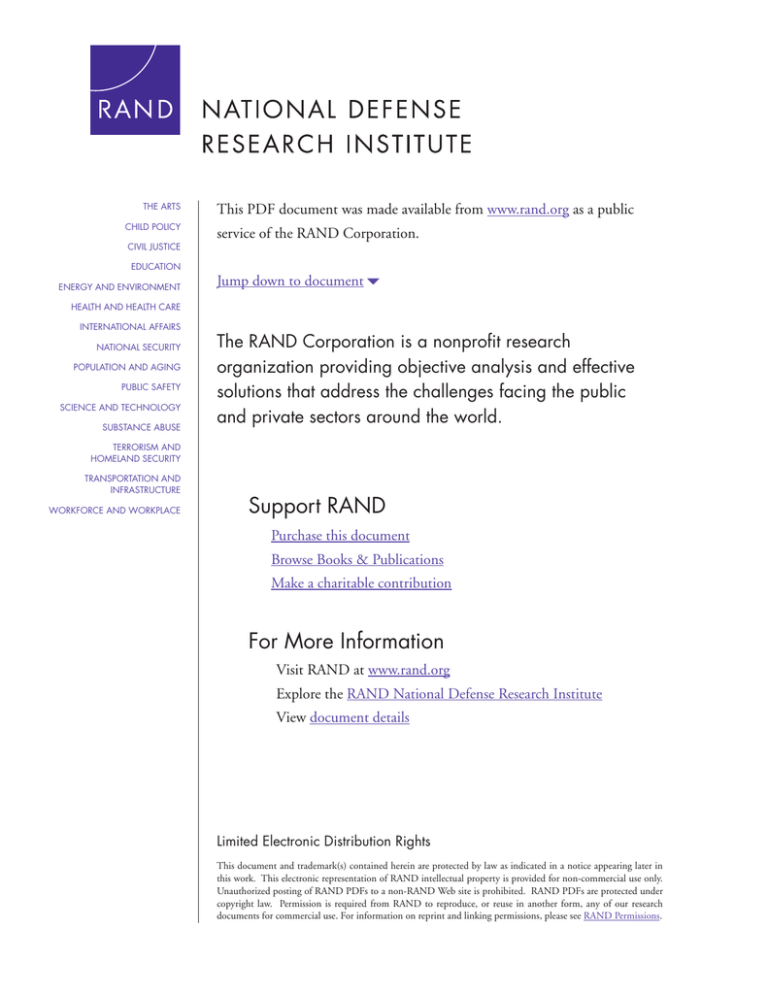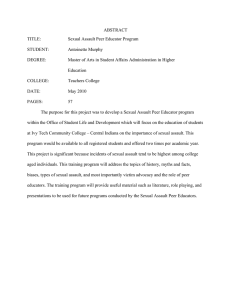6 om as a public service of the RAND Corporation.
advertisement

THE ARTS CHILD POLICY CIVIL JUSTICE EDUCATION ENERGY AND ENVIRONMENT This PDF document was made available from www.rand.org as a public service of the RAND Corporation. Jump down to document6 HEALTH AND HEALTH CARE INTERNATIONAL AFFAIRS NATIONAL SECURITY POPULATION AND AGING PUBLIC SAFETY SCIENCE AND TECHNOLOGY SUBSTANCE ABUSE The RAND Corporation is a nonprofit research organization providing objective analysis and effective solutions that address the challenges facing the public and private sectors around the world. TERRORISM AND HOMELAND SECURITY TRANSPORTATION AND INFRASTRUCTURE WORKFORCE AND WORKPLACE Support RAND Purchase this document Browse Books & Publications Make a charitable contribution For More Information Visit RAND at www.rand.org Explore the RAND National Defense Research Institute View document details Limited Electronic Distribution Rights This document and trademark(s) contained herein are protected by law as indicated in a notice appearing later in this work. This electronic representation of RAND intellectual property is provided for non-commercial use only. Unauthorized posting of RAND PDFs to a non-RAND Web site is prohibited. RAND PDFs are protected under copyright law. Permission is required from RAND to reproduce, or reuse in another form, any of our research documents for commercial use. For information on reprint and linking permissions, please see RAND Permissions. This product is part of the RAND Corporation technical report series. Reports may include research findings on a specific topic that is limited in scope; present discussions of the methodology employed in research; provide literature reviews, survey instruments, modeling exercises, guidelines for practitioners and research professionals, and supporting documentation; or deliver preliminary findings. All RAND reports undergo rigorous peer review to ensure that they meet high standards for research quality and objectivity. A Compendium of Sexual Assault Research Margaret C. Harrell, Laura Werber Castaneda with Marisa Adelson, Sarah Gaillot, Charlotte Lynch, Amanda Pomeroy Prepared for the Office of the Secretary of Defense Approved for public release; distribution unlimited NATIONAL DEFENSE RESEARCH INSTITUTE The research described in this report was prepared for the Office of the Secretary of Defense (OSD). The research was conducted in the RAND National Defense Research Institute, a federally funded research and development center sponsored by the OSD, the Joint Staff, the Unified Combatant Commands, the Department of the Navy, the Marine Corps, the defense agencies, and the defense Intelligence Community under Contract W74V8H06-C-0002. Library of Congress Cataloging-in-Publication Data is available for this publication. 978-0-8330-4792-2 The RAND Corporation is a nonprofit research organization providing objective analysis and effective solutions that address the challenges facing the public and private sectors around the world. RAND’s publications do not necessarily reflect the opinions of its research clients and sponsors. R® is a registered trademark. © Copyright 2009 RAND Corporation Permission is given to duplicate this document for personal use only, as long as it is unaltered and complete. Copies may not be duplicated for commercial purposes. Unauthorized posting of R AND documents to a non-R AND Web site is prohibited. R AND documents are protected under copyright law. For information on reprint and linking permissions, please visit the RAND permissions page (http://www.rand.org/publications/ permissions.html). Published 2009 by the RAND Corporation 1776 Main Street, P.O. Box 2138, Santa Monica, CA 90407-2138 1200 South Hayes Street, Arlington, VA 22202-5050 4570 Fifth Avenue, Suite 600, Pittsburgh, PA 15213-2665 RAND URL: http://www.rand.org To order RAND documents or to obtain additional information, contact Distribution Services: Telephone: (310) 451-7002; Fax: (310) 451-6915; Email: order@rand.org Summary Introduction Sexual assault is a violent crime that has tremendously pernicious effects on the victim. However, there is a lack of consensus regarding the prevalence of sexual assault: Estimates vary among studies, in part because of differing definitions of sexual assault, different populations studied, and different methods employed for selecting the sample. As a result, while many studies indicate that sexual assault is a pervasive problem, the estimated prevalence ranges considerably. For example, estimates of sexual assault involving female victims range in studies of community samples from 15 to 51 percent (Masho, Odor, and Adera, 2005; Ullman and Siegel, 1993; Elliott, Mok, and Briere, 2004; Randall and Haskell, 1995). One of these studies also included male subjects and found the prevalence of sexual assault victimization among those men to be 4 percent (Elliott, Mok, and Briere, 2004). Studies of college samples measured sexual assault rates at 21 to 42 percent among female samples (Combs-Lane and Smith, 2002; Easton et al., 1997; Fisher, Cullen, and Turner, 2000; Gross et al., 2006; Kalof, 2000a; Nasta et al., 2005; Synovitz and Byrne, 1998; Krebs et al., 2007). Studies that focused specifically on military samples have reported a range from 2 percent to 51 percent for female subjects (Lipari, Lancaster, and Jones, 2005; Sadler et al., 2003; Skinner et al., 2000; Martin, Rosen, et al., 1998; Merrill et al., 1998), and in those that included male military subjects, up to 7 percent of the men studied had been sexually assaulted (Lipari, Lancaster, and Jones, 2005, and Martin et al., 1998). Finally, one prominent large-scale study has estimated a national prevalence for rape or attempted rape of women at approximately 18 percent (Tjaden and Thoennes, 2000).1 In spite of this variation in prevalence rates—or perhaps as a result of it—recognition of sexual assault, and especially of acquaintance rape, has dramatically increased in recent decades. The 1990s witnessed important legal reforms regarding sexual assault on college campuses, including requirements for colleges to publicly disclose crime statistics and crime prevention activities. Parallel to the civilian reforms, there were also notable revisions to law, policy, and practice regarding responses to sexual assault in the military community. Although the allegations of sexual assaults perpetrated by military personnel against both men and women during the 1991 Tailhook convention, a gathering of Navy aviators, had received considerable attention, the issue was somewhat dormant until the 2000 Air Force Inspector General (IG) investigation of sexual assault at the Air Force Academy. This in turn prompted additional 1 Of the studies cited here, Elliott, Mok, and Briere, 2004; Tjaden and Thoennes, 2000; Lipari, Lancaster, and Jones, 2005; Martin et al., 1998; and Merrill et al., 1998, include mixed-gender samples. The other studies include only women in their samples. ix x A Compendium of Sexual Assault Research investigations and was subsequently followed by the establishment of the U.S. Department of Defense (DoD) Sexual Assault Task Force (to investigate sexual assault allegations among deployed service members), the Task Force on Sexual Harassment and Violence at the Military Academies, and the creation of the Sexual Assault Prevention and Response Office within DoD. These legal reforms and other events informed, and were informed by, a large and diverse body of empirical research that has rapidly grown in recent decades. This body of work is represented in this compendium, which categorizes and summarizes publications related to different aspects of sexual assault. In each section, we discuss the included research and provide a table summarizing the subjects, sample size, method, objective, and selected findings of each publication.2 We list the highlights of each section in the remainder of this summary. Additionally, this document concludes with an annotated bibliography of the included research. Victim and Perpetrator Risk Factors The majority of studies regarding the risk factors for victims or perpetrators of sexual assault have focused on incidents involving a female victim and a male perpetrator. A common finding is that a victim’s prior sexual assault is a significant predictor of future or additional sexual assault. The research also suggests that youth, lower-income status, and African-American ethnicity were additional victim risk factors. Studies of assault victims have indicated that intimate partners, and not strangers, are most frequently the perpetrators of assault. Among perpetrators, hostile masculinity was most often found to be a significant predictor of sexual assault perpetration; men who adhered to aggressive sexual beliefs were also considered at high risk of perpetrating sexual assault, as were those with a history of being coercive or committing assault. Context and Prevention of Sexual Assault Much of the research addressing the prevention of sexual assault consists of evaluations of various prevention programs. Many of the programs focus on the identification and reversal of rape-supportive attitudes and perceptions, such as those commonly referred to as “rape myths.” Examples of rape myths include “women secretly want to be raped” and “rapists are almost always strangers.” Other programs address specific behaviors or the interpretations of sexual scenarios. While most evaluations of these programs have relied on the reported change in attitudes or intended behavior, some did measure actual outcomes, such as subsequent victimization. In general, the studies indicate the limitations of sexual assault prevention programs. While many programs indicate a beneficial outcome, those outcomes tend to diminish over time, as measured by follow-up assessments. 2 Throughout this compendium, we provide only selected findings in the summary tables and tend especially not to focus on null findings. Interested readers are encouraged to refer to the original work for more details of the research. Additionally, the N reported in the summary tables and abstracts reflects the total number of data points on which findings are based. The sample size may vary through a study because of attrition over time, for example, or because participants did not complete all data-collection instruments. Summary xi Recovery and Coping Another portion of sexual assault research addresses the issue of how victims respond to sexual assault. We place into this category research that emphasizes the physical and mental health outcomes of sexual assault and victims’ coping mechanisms.3 The physical health outcomes include sexually transmitted diseases, gynecological or reproductive problems, and other physical problems, such as hypertension, high cholesterol, and heart attack. The mental health outcomes can include posttraumatic stress disorder, depression, and other potentially related consequences, such as eating or sleep disorders. This research also addresses factors that positively influence victim recovery, such as the role of social support. Many of these studies used victim attributes or incident characteristics to help explain the variation in victim recovery. Sexual Assault Disclosure Many studies of sexual assault focus on to whom a victim discloses an assault, the factors related to the victim’s disclosure decision, and the reactions to victims by formal support providers. This research indicates generally that victims are more likely to disclose to informal support providers, such as family and friends, than to formal support providers. Many of the studies attempt to identify the factors that influence the decision of whether to disclose an assault to the police or to present for medical treatment, and these factors typically include the victim or perpetrator race, gender, co-occurrence with another crime, alcohol consumption, additional injury, and the relationship between the victim and perpetrator. This research also explores the relationship between concerns about secondary victimization and other negative social reactions that contribute to victim feelings of shame or embarrassment. Broadly, obtaining a better understanding of reasons for nondisclosure—that is, reasons for underreporting—was a goal of many of these studies. Reasons included both perceived and psychological barriers as well as concrete obstacles, such as a lack of resources. Health Care Programs and Services This body of research addresses the programs and professionals involved in providing medical treatment to sexual assault victims, as well as the types of treatments involved and the effectiveness of the treatments. The majority of this research concerns civilian Sexual Assault Nurse Examiner (SANE) programs. SANEs are registered nurses with additional education and clinical training on interacting with sexual assault victims. The research generally indicates an improved quality of care received from SANE programs. 3 Some of these studies consider revictimization as a post-assault outcome, but we discuss findings of this nature in the aforementioned victim risk factors section (Section 2). xii A Compendium of Sexual Assault Research Victim Advocacy Programs and Services Victim advocacy services are typically offered by rape crisis centers, organizations expressly dedicated to victim advocacy (even beyond sexual assault), and institutions focused on counseling services. The majority of victim advocacy studies involved an assessment of program or service effectiveness, and the research suggests that program effectiveness varied, at least in part due to the different measures used; some were objective, while others, such as victim perceptions, were more subjective. Investigative and Legal Processes This research includes a wide range of studies assessing the progress of sexual assault incidents through the criminal justice system. Some of these studies attempt to identify the factors that influence whether law enforcement personnel question a suspect or determine a case to be founded. These studies also examine whether and how forensic and medical evidence and other individual and case-related factors predict legal outcomes. For example, some research indicates that the quality and source of forensic evidence improves investigative and legal outcomes, as does participation in SANE or Sexual Assault Response Team (SART) programs. Research also indicates that victim behaviors, such as risk-taking, and victim characteristics are related to legal outcomes. This research also indicates the extent to which ill-informed or negative perceptions of law enforcement and legal personnel toward assault victims can affect outcomes.


